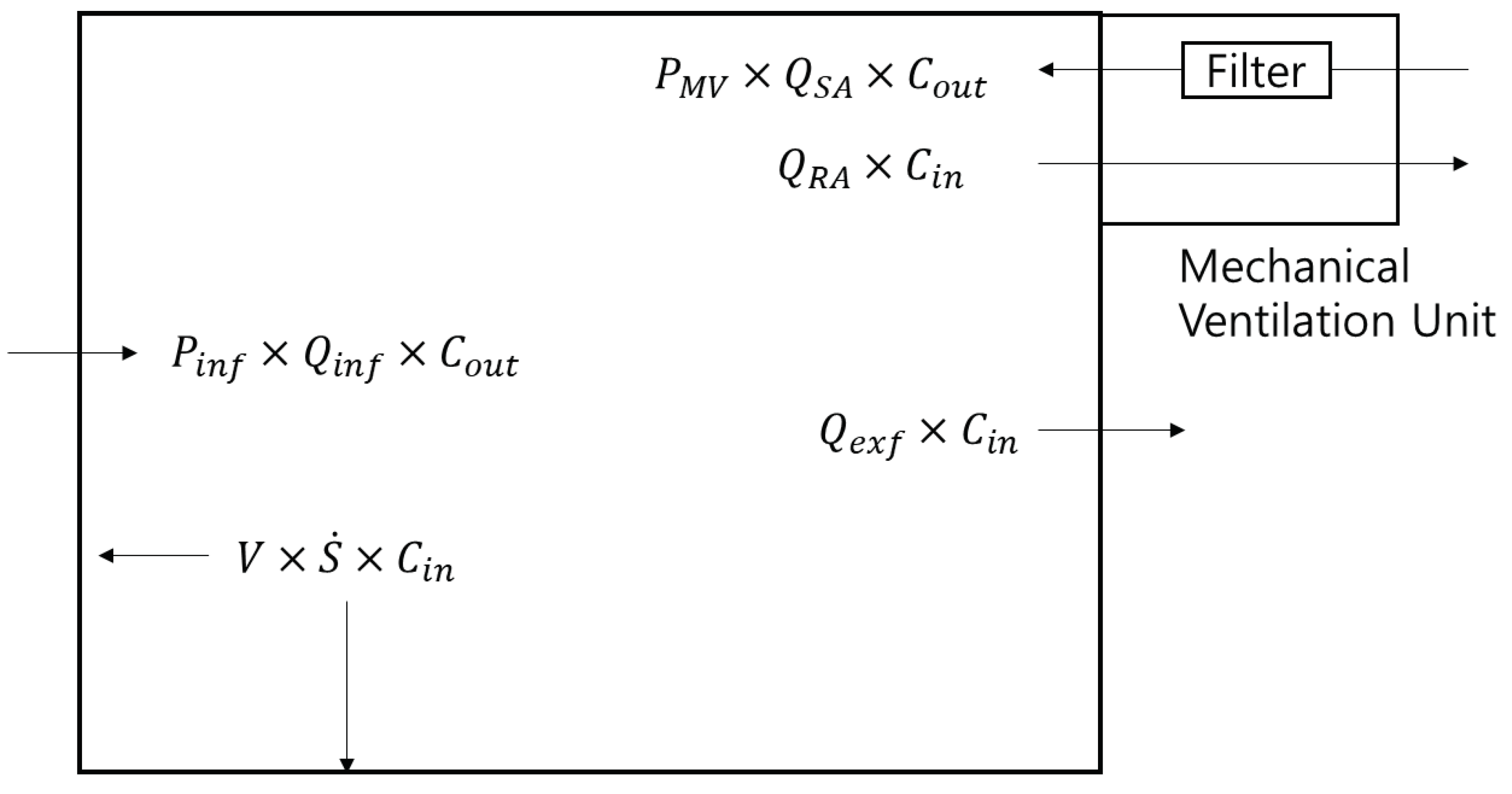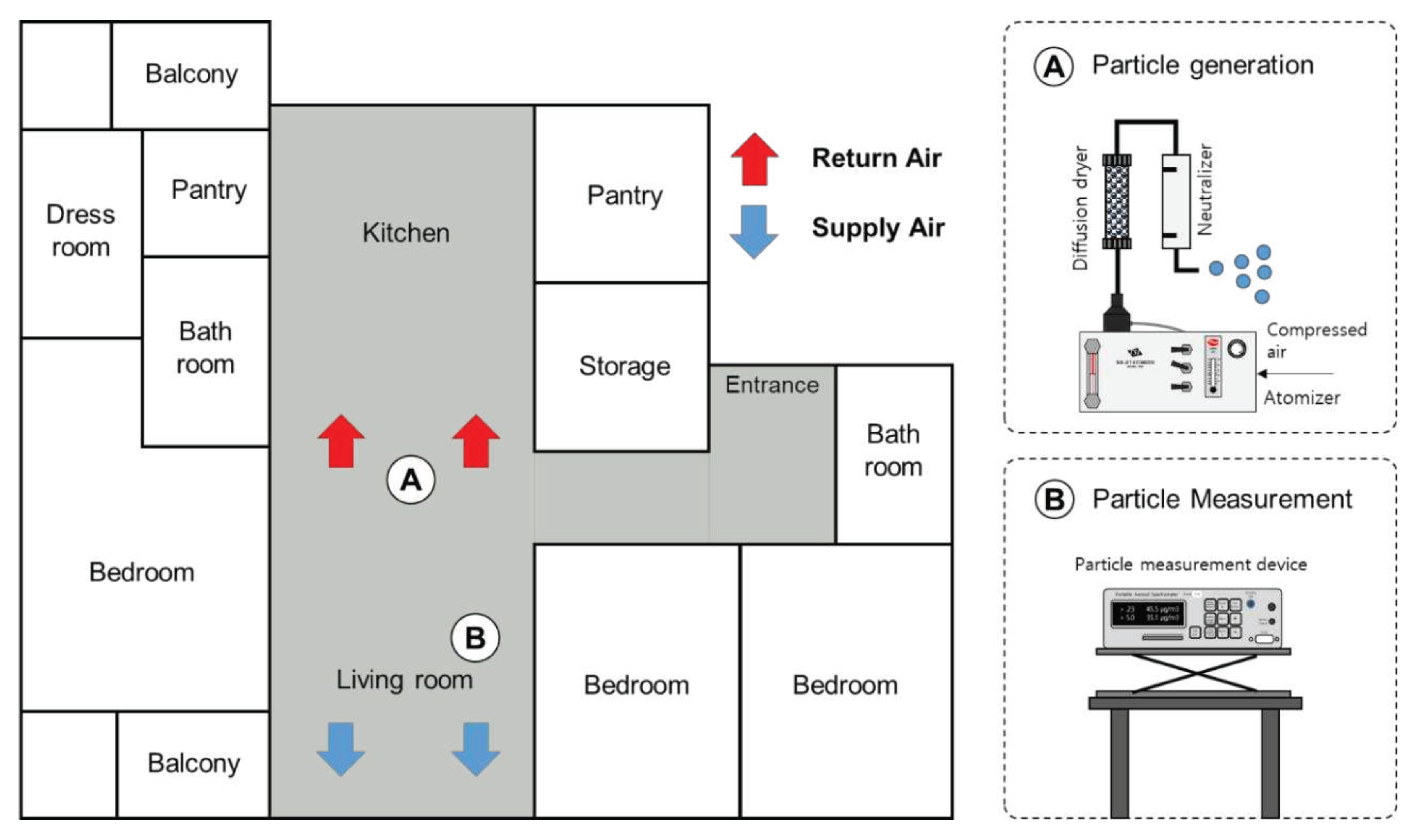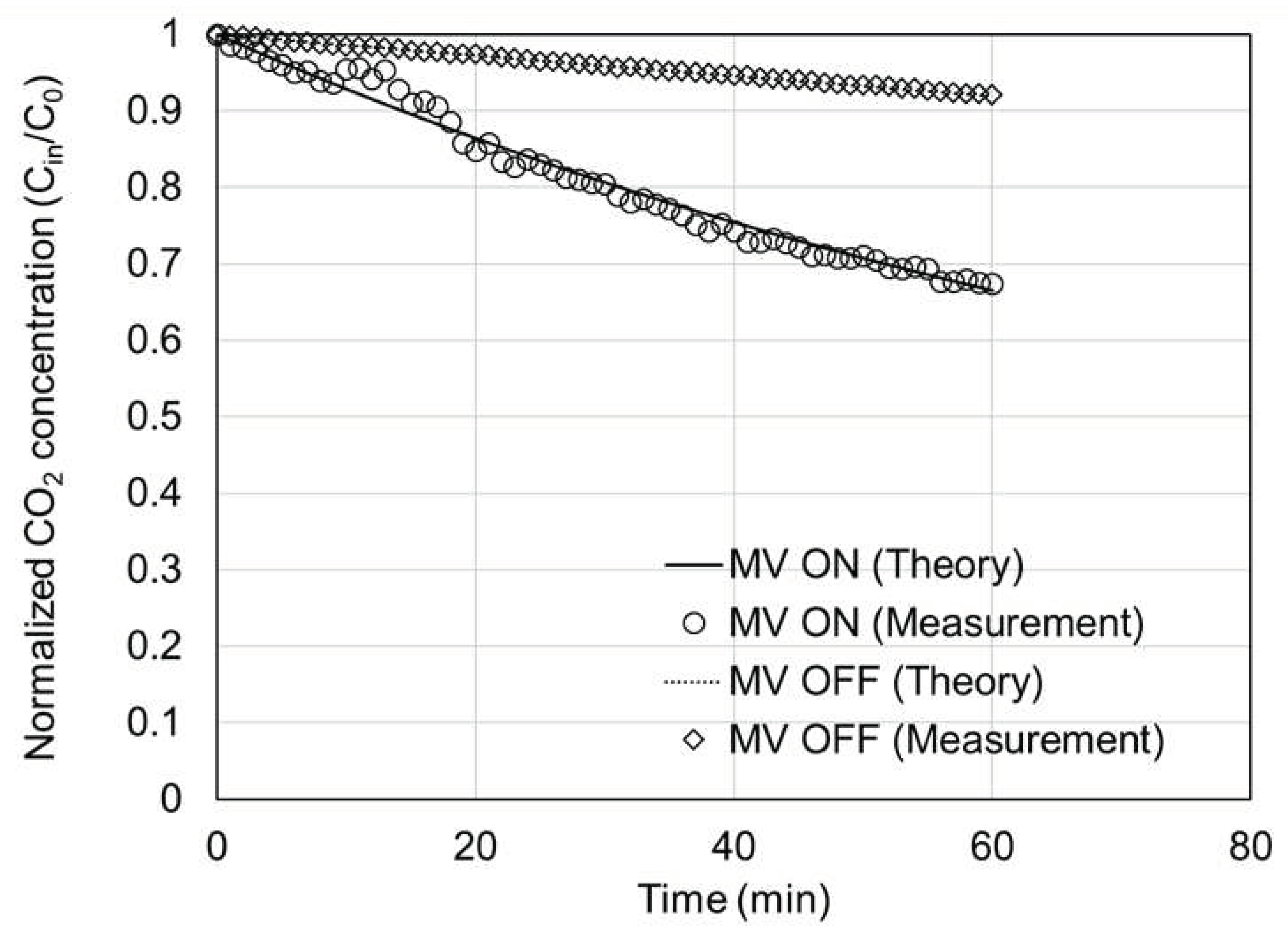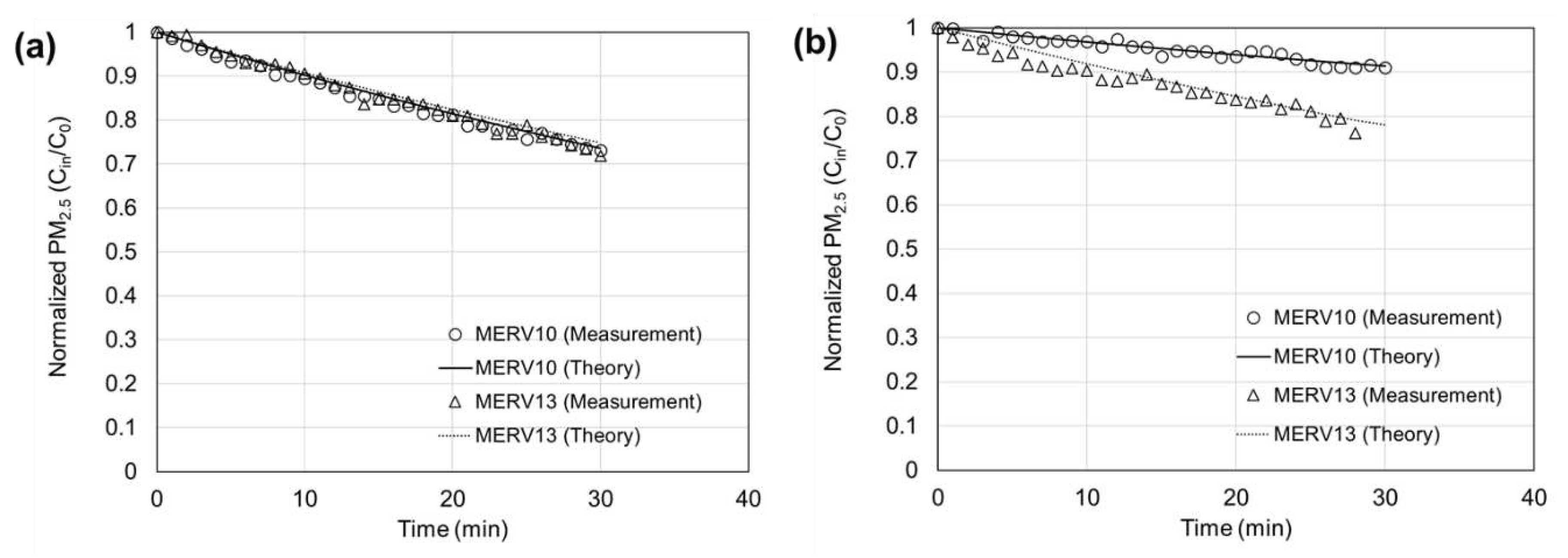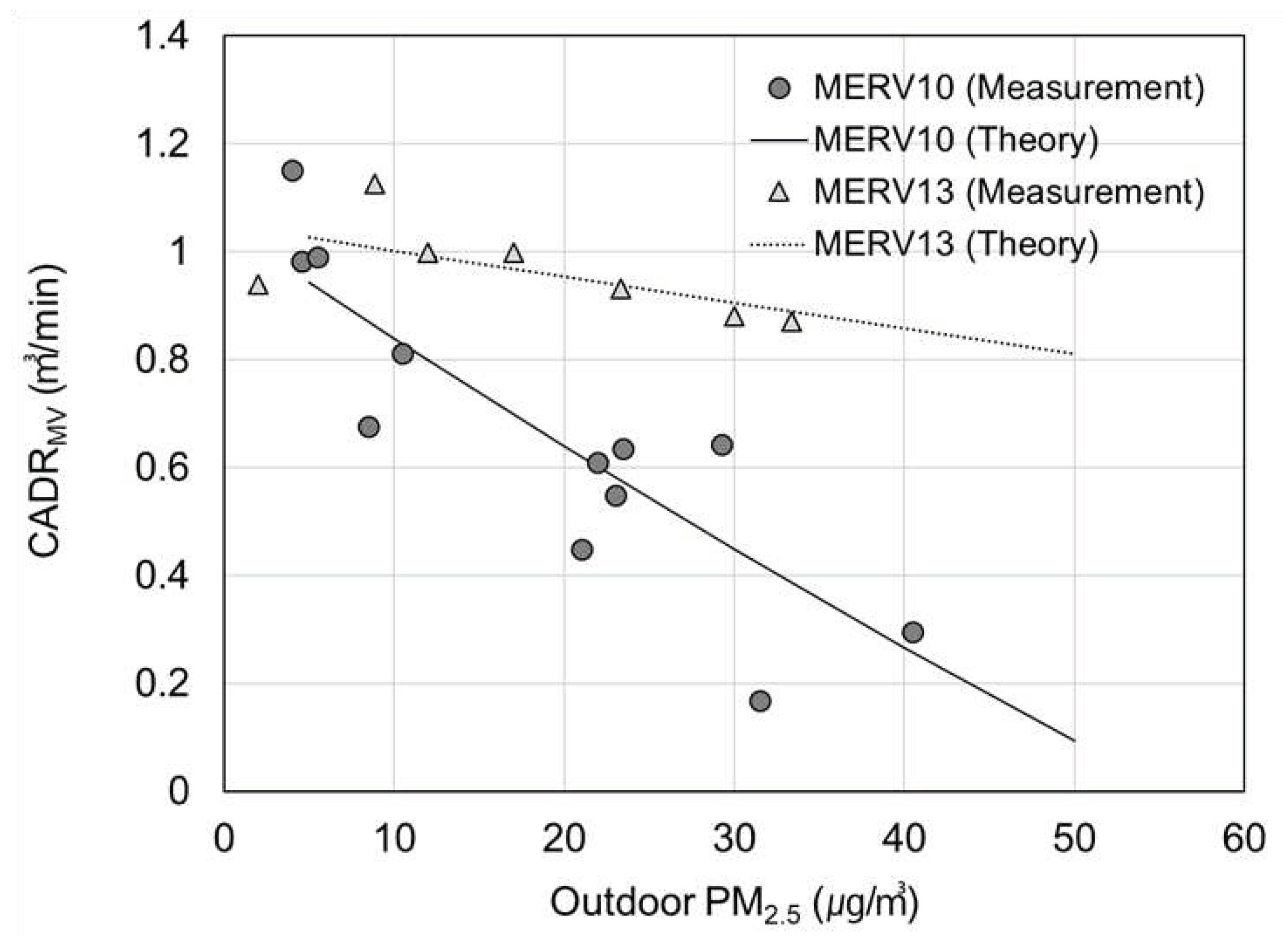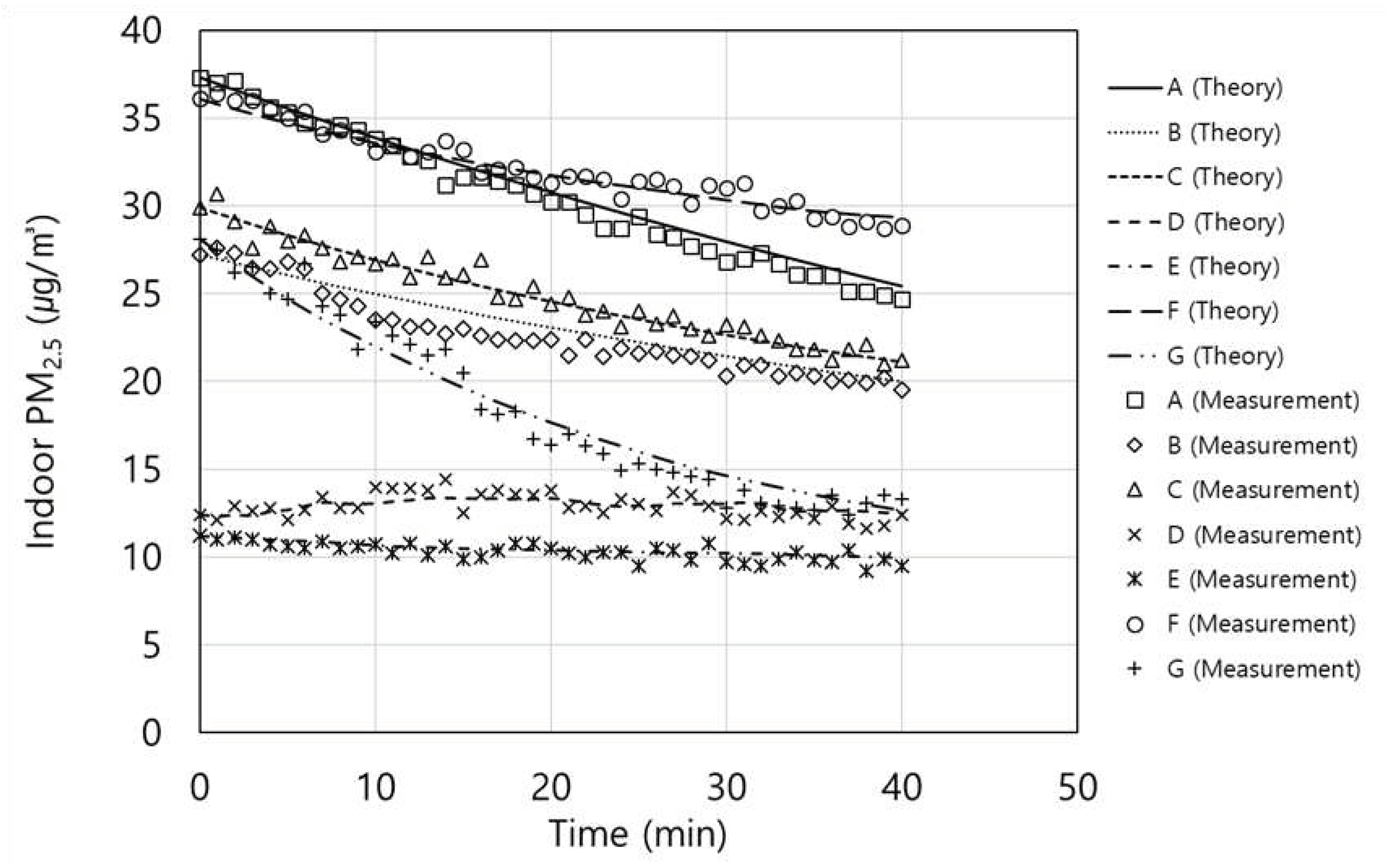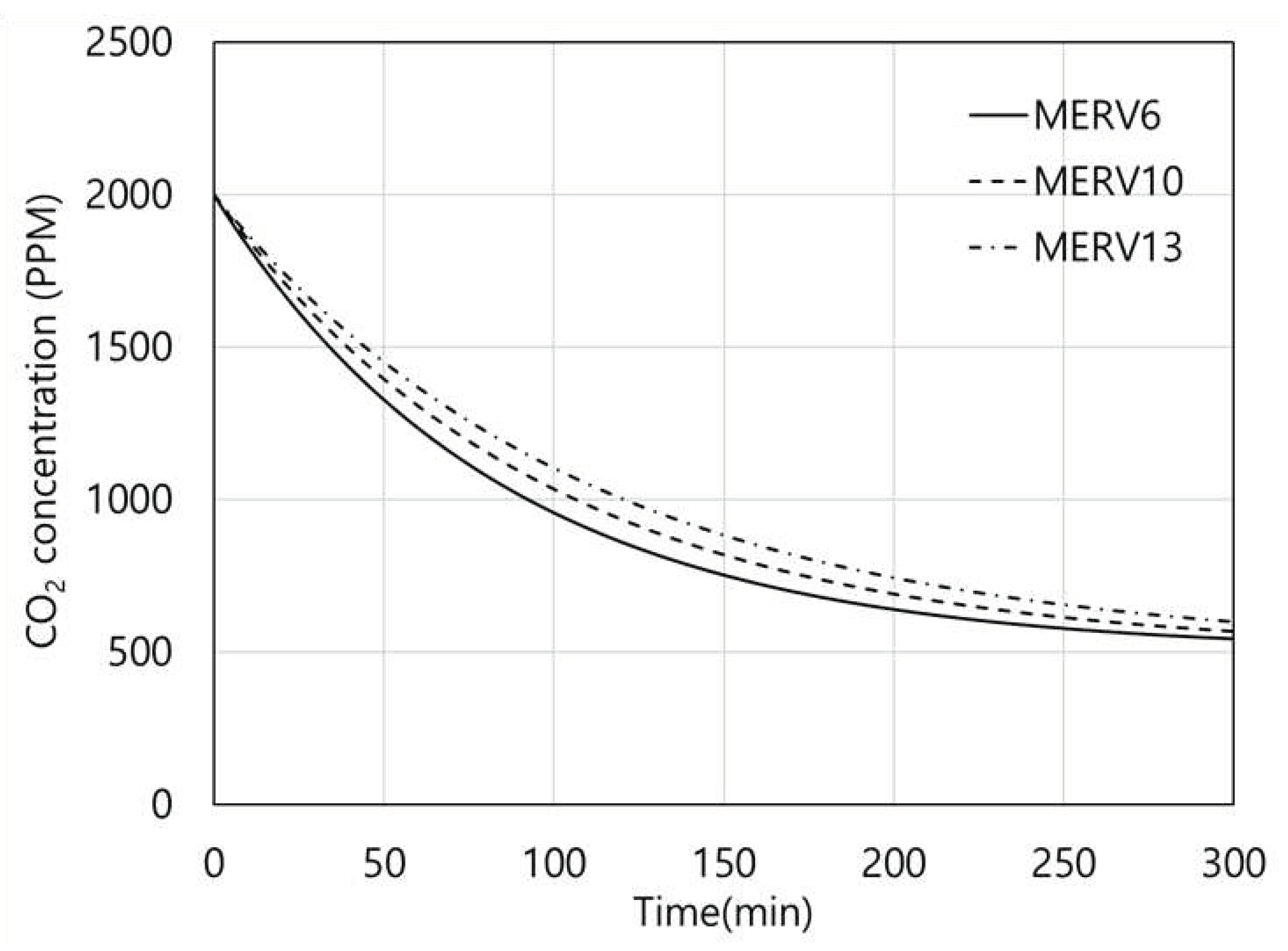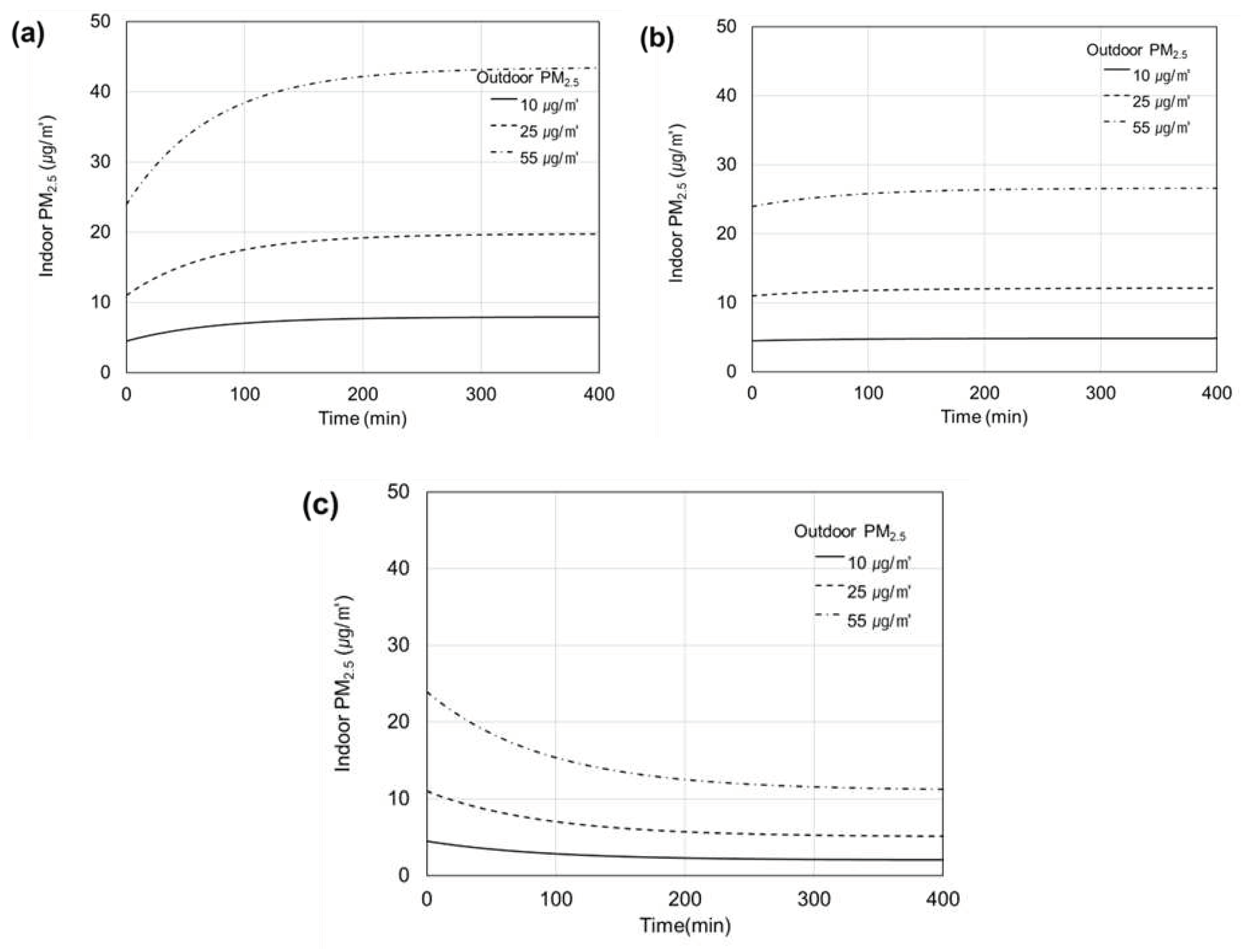1. Introduction
People spend a significant proportion of their time indoors[
1,
2,
3]. This includes the time spent in residences, where they sleep and eat, and in workplaces. Commuting using public transportation or vehicles to reach the workplace is a substantial indoor activity. A major portion of time is dedicated to being indoors.
Primary pollutants originating from indoor environments encompass a wide range of sources. These include airborne microorganisms from humidifiers, air-conditioning units, refrigerators, pets, and food waste[
4,
5]. Formaldehyde is also emitted by furniture, insulating materials, and plywood[
6,
7,
8]. Moreover, acetone emissions from synthetic resins and adhesives, and combustion gases (carbon monoxide and oxides of nitrogen and sulfur), arise from stoves and gas ranges[
9,
10]. Radon arising from latex matrices and building materials[
11], along with volatile organic compounds from cigarette smoke and fine particulate matter, are also prevalent indoor contaminants[
12,
13,
14].
Prolonged exposure to these pollutants can lead to skin conditions, respiratory illnesses, and even lung cancer[
15]. Furthermore, recent research has suggested that fine particulate matter can affect the stomach and colorectal cancer[
16]. However, the recognition of indoor pollutants is often challenging. One method to mitigate indoor pollution is frequent ventilation of indoor spaces via opening windows. Nonetheless, on days with high outdoor particulate matter levels, natural ventilation may increase indoor particulate matter concentrations, which could lead to energy losses during summer and winter owing to heating or cooling[
17,
18]. Consequently, mechanical ventilation systems are required, and extensive researches are being conducted on managing indoor air quality using such systems.
Mechanical ventilation systems are designed to bring in outdoor air and expel indoor air, utilizing the heat exchange between indoor and outdoor air to minimize heating and cooling losses. In addition, these systems are equipped with filters to prevent the influx of fine particulate matter and ensure clean air supply[
19]. Starting in 2006, South Korea introduced mandatory ventilation systems in residential complexes with more than 100 units[
20]. Consequently, many apartment buildings are equipped with mechanical ventilation systems. Regulations on filter efficiency based on the outdoor air intake have also been strengthened. Currently, ventilation systems in residential complexes and multi-use facilities are required to achieve a capture efficiency of over 60% using particle counting methods. While residential complexes have a specified minimum ventilation rate of at least 0.5 air change per hour, multi-use facilities regulate ventilation based on the per-person ventilation rate.
Various studies have defined the factors that influence indoor air quality and assessed their impacts. Noh and Yook (2016) evaluated the effectiveness of air purifiers and their circulation effects in university lecture rooms[
21]. Martins and da Graca (2017) reported that outdoor fine particulate matter (PM
2.5), which infiltrates indoors via natural ventilation, is the primary source of indoor PM
2.5[
22]. Ben-David and Waring (2016) simulated the impacts of natural and mechanical ventilation on indoor pollutant concentrations and energy usage in office buildings, and proposed ventilation strategies[
23]. Ruan and Rim (2019) measured indoor PM
2.5 and ozone concentrations based on air handling unit and occlusion-aware filter efficiency in office houses and analyzed the effects of filter efficiency and outdoor air concentration on indoor PM
2.5 concentrations[
24]. They also conducted an analysis of the influence of ventilation rates and filter efficiency on indoor PM
2.5 and ozone concentrations in office buildings. Despite the diverse range of studies on pollutant control via mechanical ventilation, most have focused on ventilation devices in office spaces. Research analyzing the effects of ventilation systems in actual residential houses remains limited.
In this study, the indoor concentrations based on filter efficiency were measured in residential mechanical ventilation systems. Variations in indoor PM2.5 concentrations were analyzed between periods of high and low outdoor PM2.5 concentrations. Furthermore, a mass-balance model was formulated to compare the actual measurements with theoretical values, deriving an equation that accurately predicted the indoor PM2.5 concentrations. The accuracy of this equation was verified not only in experimental houses but also in various other residential houses. This study thus devised an approach to predict indoor PM2.5 concentrations using mechanical ventilation systems based on outdoor PM2.5 concentrations and ventilation system filter grades. This approach aims to maintain indoor PM2.5 concentrations below 10 µg/m³.
2. Materials and Methods
Figure 1 depicts a schematic that models the factors affecting indoor particle concentrations when a ventilation system is used in an actual residential house.
The factors that influence the indoor concentrations applied in the model include particles entering and exiting via the ventilation system, via the building envelope, and particles settling naturally. Through the modeling process, an equation describing the variation in indoor concentrations over time was formulated as follows:
Here,
represents the indoor PM
2.5 concentration,
is the volume of the interpreted space,
is the indoor supply airflow rate due to the ventilation system,
is the particle penetration coefficient of the ventilation system filter,
is the particle penetration coefficient through the apartment envelope,
is the airflow rate entering through the apartment envelope,
is the outdoor PM
2.5 concentration,
is the airflow rate exiting the indoor space through the apartment envelope, and
is the deposition rate by settling. Solving the differential equation in Equation (1) leads to the following Equation (2):
Equation (2) represents the indoor PM2.5 concentration over time as an exponential function of its relationship with the outdoor PM2.5 concentration. In this study, current indoor PM2.5 concentration (Cin(ti)) was influenced by the prior indoor PM2.5 concentration (Cin(ti-1)) and inflow of the prior outdoor PM2.5 concentration (Cout(ti-1)). Here, the real-time outdoor PM2.5 concentration was measured and applied at one-minute intervals for calculation.
Figure 2 shows the experimental setup used to investigate the changes in indoor particle concentrations using ventilation systems in a residential house. The experiment was conducted in an apartment with a dedicated area of 72 m² built in 2018. Only the kitchen and living room areas were utilized for the experiment, with a calculated volume of 84 m
3. Particle measurements were performed at location B using an optical particle counter (1.109, Grimm Aerosol Technik, Ainring, Germany) placed on a table in the living room. The test particles were generated at location A using a potassium chloride 1% solution in a six-jet atomizer (9306, TSI, MN, USA), which passed through a diffusion dryer to remove moisture, and neutralized using a neutralizer (3012, TSI) with a krypton-85 source. A ventilation system was installed on the exterior side of the living room ceiling with two supply and exhaust diffusers connected to the living room and kitchen. The flow rate of the diffusers was measured using dedicated equipment, revealing a combined supply flow rate of 44 m³/h and exhaust flow rate of 56 m³/h. To determine the infiltration and exfiltration flow rates through the apartment envelope, airtightness measurements were conducted following standardized tests (EN13829[
25] and ASTM E779-10[
26]) and compared with the decay of carbon dioxide (CO
2) concentrations under normal temperature and pressure conditions.
In this study, the clean air delivery rate (CADR), a metric commonly used to indicate air purifier performance, was used to quantify the particle removal efficiency of the ventilation system. CADR represents the volume of clean air delivered by an air purifier per unit of time and is calculated via multiplying the airflow rate of the air purifier by the particle collection efficiency of the filter. Similarly, ventilation systems supply clean air via filtering out pollutants from the incoming outdoor air. Therefore, the particle reduction effect of the ventilation system can be expressed using the CADR ventilation system. It is defined by the following equation:
CADR, as defined by the standard test protocol (SPS-KACA002-132[
27]), is calculated as the product of the slope of the indoor concentration decay curve over time and experimental space volume. However, in actual residential houses, indoor particle concentrations often exhibit a decay pattern in the form of C
in(t) = exp(−kt) + A, rather than a simple exponential decay of C
in(t) = exp (−kt). Therefore, defining CADR in an actual environment requires adopting a formulation similar to the aforementioned pattern. In this study, t
1 for CADR via mechanical ventilation (CADR
MV) was considered as approximately 2–3 min after the operation of the ventilation system, and t
2 was set to 20 min after t
1. According to the standard testing protocol SPS-KACA002-132, more than 20 measurement points or measurements should be marked until the time is equal to 1/10 of the initial particle concentration. Hence, the duration t
2−t
1 was set to 20 min. Using Equation (2) for calculations and fitting, the results indicated that when the time exceeded 40 min, the R
2 value decreased below 0.99. Based on this observation, Equation (3) was concluded to be utilized to calculate CADR
MV to accurately define the purification capability of the ventilation system.
In this study, filters with minimum efficiency reporting value (MERV) ratings of 10 and 13 were used and compared. Following the standard testing protocol SPS-KACA002-132, tests were conducted to determine the fine particle removal efficiencies of the filters. The efficiency of PM2.5 for the MERV 10 filter was approximately 7%, whereas the MERV 13 filter exhibited an efficiency of around 90%. The particle reduction effects originating from the ventilation system were examined via comparing differences in particle capture efficiency between these filters.
3. Results
Figure 3 shows the measured changes in CO
2 concentration over time when only the ventilation system was and was not operated after introducing CO
2 into the test house. A comparison was made between the results calculated using Equation (2) and the actual measured data.
First, the measured and theoretical values were compared without operating the ventilation system. The air leakage rate of the test house, as measured using the building envelope standard test, showed an ACH50 value of 2.1 air changes per hour (ACH). This value can be converted to ACH under atmospheric pressure conditions by dividing ACH50 by 20 [
28], resulting in an ACH of 0.11 for the test house. Using this, the calculated value of
is 0.13 m³/h. Applying this value to Equation (2), the calculated MV OFF value was obtained to be a level of 92% after 60 min. The measured value of MV OFF exhibited a similar trend, reaching 92% after 60 min with an error within 0.5%.
Second, the measured and theoretical values were compared after the ventilation system was operated. The airflow rates of the supply and exhaust diffusers were measured to be 44 m³/h and 56 m³/h, respectively. These airflow rates were applied to Equation (2) for calculation and comparison with the measured data. The measured PM2.5 concentration after 60 min became approximately 67% compared to the initial one, which is consistent with the theoretical value.
Figure 4 is a graph illustrating the variation in indoor PM
2.5 concentration over time. The graph compares the reduction levels based on the rating of the ventilation system filter and thus compares the measured values with those calculated using Equation (2). The ventilation system used for comparison employed filters with MERV ratings of 10 and 13, representing low- and high-performance filters, respectively.
Figure 4(a) shows measurements taken on days when the outdoor PM
2.5 concentration was below 5 μg/m³. The initial indoor PM
2.5 concentration was set to 47 μg/m³, and the ventilation system was operated for a total of 60 min. The results showed that with the use of MERV 13 filters, the PM
2.5 concentration became 72% of the initial value, whereas with MERV 10 filters, the concentration became 73%. This indicates that the filter performance does not significantly impact indoor concentration when the outdoor PM
2.5 concentration was sufficiently low.
Figure 4(b) shows a graph depicting the effect of indoor PM
2.5 reduction over time through the operating the ventilation system on days when the outdoor PM
2.5 concentration ranged from 30 to 40 μg/m³. Using relatively high-efficiency MERV 13 filter, the concentration after 60 min became 76% of the initial value. Conversely, with the relatively low-efficiency MERV 10 filters, the concentration became approximately 91% of the initial value. This indicates that when the outdoor PM
2.5 concentration is higher, the dust particle concentration in the air supplied through the ventilation system increases, significantly influencing the indoor PM
2.5 reduction capability. Furthermore, by comparing the calculated results from Equation (2) with the measured values, the error was found to be within 1%.
Figure 5 shows CADR
MV according to outdoor PM
2.5. Measurements were conducted via alternating the application of MERV 10 and 13 filters to the ventilation system while varying the outdoor PM
2.5. The goal of these experiments was to analyze the indoor fine particle removal efficiency of the ventilation system based on outdoor PM
2.5 and filter ratings. Twelve measurements were performed using MERV 10 filters and seven measurements were performed using MERV 13 filters. In the figure, the circular data points represent the actual measured values, whereas the lines indicate the CADR
MV values calculated using the theoretical equation. The measured and calculated values were evidently in good agreement. Furthermore, on days when the outdoor PM
2.5 was below 5 μg/m³, CADR
MV ranged from 0.9 to 1.2 m³/min regardless of the filter grade. However, as the outdoor PM
2.5 concentration increased, the CADR
MV decreased, and the decrease rate varied based on the filter grade. When using MERV 10 filters, at an outdoor PM
2.5 concentration of 50 μg/m³ (considered “unhealthy” air quality), CADR
MV dropped to 0.09 m³/min, which was ten times lower compared to 0.94 m³/min at 5 μg/m³. For MERV 13 filters, at an outdoor PM
2.5 concentration of 50 μg/m³, CADR
MV decreased to 0.81 m³/min, 1.3 times lower compared to 1.03 m³/min at 5 μg/m³. This demonstrates that filter efficiency significantly affects the air purification capability of the ventilation system.
Figure 6 presents the comparison between the measured indoor PM
2.5 concentrations and calculated results using Equation (2) for seven residential houses (apartments) constructed between 2013 and 2018. The experiments were conducted via opening windows of each apartment to allow outdoor air to enter and equilibrate with the outdoor PM
2.5. Subsequently, the windows were closed and ventilation systems were operated to measure the reduction in indoor PM
2.5 concentrations.
Table 1 provides information on the construction year, floor area, test volume, supply and exhaust airflow rates of the ventilation systems, filter efficiency, and other parameters used in the calculations. The ACH50, initial particle concentration, outdoor PM
2.5 concentration, deposition rate, particle penetration through walls, and other relevant values used in Equation (2) are also included. The window frames in all apartments were made of polyvinyl chloride; for apartments constructed within the last 10 years. For all apartments, the ACH50 value of 2.1/h measured from Apartment A was applied because their construction years were similar. When the construction year is similar, it has been observed that the air leakage rate tends to be comparable [
29].
Atmospheric particles were used as test particles, and indoor and outdoor PM2.5 concentrations were simultaneously measured and incorporated into the equation. This study examined the use of various ventilation systems with different performance levels for different house types. When applying the equation established in this study, the degree of reduction in indoor PM2.5 concentrations was observed to vary. In particular, for houses D and E with low-efficiency (under 40%) filters, a phenomenon has been observed where, over time, the indoor PM2.5 concentration became similar to or even higher than the outdoor PM2.5 concentration when the initial concentration was lower than that outdoors. The equation aligned well with the observed data, particularly in cases where different ventilation system performances and filter efficiencies were applied. The filter performance when using the ventilation system was confirmed to have the most significant impact on indoor PM2.5 concentrations.
4. Discussion
A measurement analysis of the indoor concentration reduction achieved using ventilation systems in apartments was performed and represented using mathematical equations for comparison. Through previous experiments, this equation was verified to closely approximate the actual measured values. In the future, utilizing this equation will allow the prediction of indoor fine PM2.5 concentrations during ventilation system operation based on outdoor PM2.5. This can help propose methods for operating ventilation systems to reduce indoor exposure to fine particulate matter.
The impact of filter efficiency on indoor PM2.5 concentrations during operating the ventilation system was confirmed. Different MERV-rated filters result in different pressure differences and airflow rates within the ventilation system. Higher pressure differences lead to reduced airflow rates, subsequently lowering the frequency of the indoor air exchange. Equation (2) was employed to analyze the reduction in CO2 and PM2.5 concentrations based on filter efficiency. The analysis was conducted for different outdoor PM2.5 concentration levels: good, moderate, and unhealthy.
Figure 7 depicts the calculated CO
2 concentration over time using Equation (2) while considering three different filter grades and varying airflow rates resulting from filter pressure differences. MERV 6, 10, and 13 filters were utilized with airflow rates of 52, 44, and 39 m³/h, respectively. The initial CO
2 concentration was set at 2000 ppm, and the simulation was conducted for 300 min of ventilation system operation. The times required to reach the indoor air quality standard of 1000 ppm or less was 93, 107, and 121 min for MERV 6, 10, and 13 filters, respectively. As the filter grade of the ventilation system increases, it leads to higher pressure differences and reduced airflow rates. It can result in lower CO
2 removal capacity of the ventilation system.
Figure 8 shows the changes in indoor PM
2.5 concentration over a 400-minute period using different MERV filter grades when the outdoor PM
2.5 concentration is classified as “good,” “moderate,” or “unhealthy.” Fig. 8(a) shows the use of the MERV 6 filter. The initial indoor PM
2.5 concentration was assumed to the half of outdoor PM2.5 concentration [
30]. The filter efficiency of the MERV 6 filter for PM
2.5 was set to 10%. When the outdoor PM
2.5 concentration is at the “good” level of 10 μg/m³, the initial indoor PM
2.5 concentration is 4.5 μg/m³, increasing over time to reach 8.6 μg/m³ in a saturated state. When the outdoor PM
2.5 concentration is at the “moderate” level of 25 μg/m³, the initial indoor PM
2.5 concentration is 11 μg/m³, increasing to 19.7 μg/m³ in a saturated state. When the outdoor PM
2.5 concentration is at the “unhealthy” level of 55 μg/m³, the initial indoor PM
2.5 concentration is 23.9 μg/m³, increasing to 43.3 μg/m³ in a saturated state. Using a low-efficiency filter in the ventilation system can increase the indoor PM
2.5 concentration.
As shown in
Figure 8(b), a MERV 10 filter with a filter efficiency of 50% was used. After 400 min, when reaching a saturated state, the indoor PM
2.5 concentration was 4.8 μg/m³ for an outdoor PM
2.5 concentration of 10 μg/m³, 12.1 μg/m³ for 25 μg/m³, and 26.6 μg/m³ for 55 μg/m³. Overall, the use of the MERV 10 filter tended to maintain or slightly increase the initial PM
2.5 concentration.
Figure 8(c) shows a MERV 13 filter with a filter efficiency of 97%. After 400 min, when reaching a saturated state, the indoor PM
2.5 concentration is 2.0 μg/m³ for an outdoor PM
2.5 concentration of 10 μg/m³, 5.1 μg/m³ for 25 μg/m³, and 11.2 μg/m³ for 55 μg/m³. Overall, the indoor PM
2.5 concentration decreased when using a MERV 13 filter.
Based on these findings, it is very important to select a relatively high efficiency filter for the ventilation system while a ventilation rate meets the regulatory ventilation requirement. This combination of enough ventilation and high-efficiency filtration is conclusively essential for maintaining indoor PM2.5 concentrations of 10 μg/m³.
